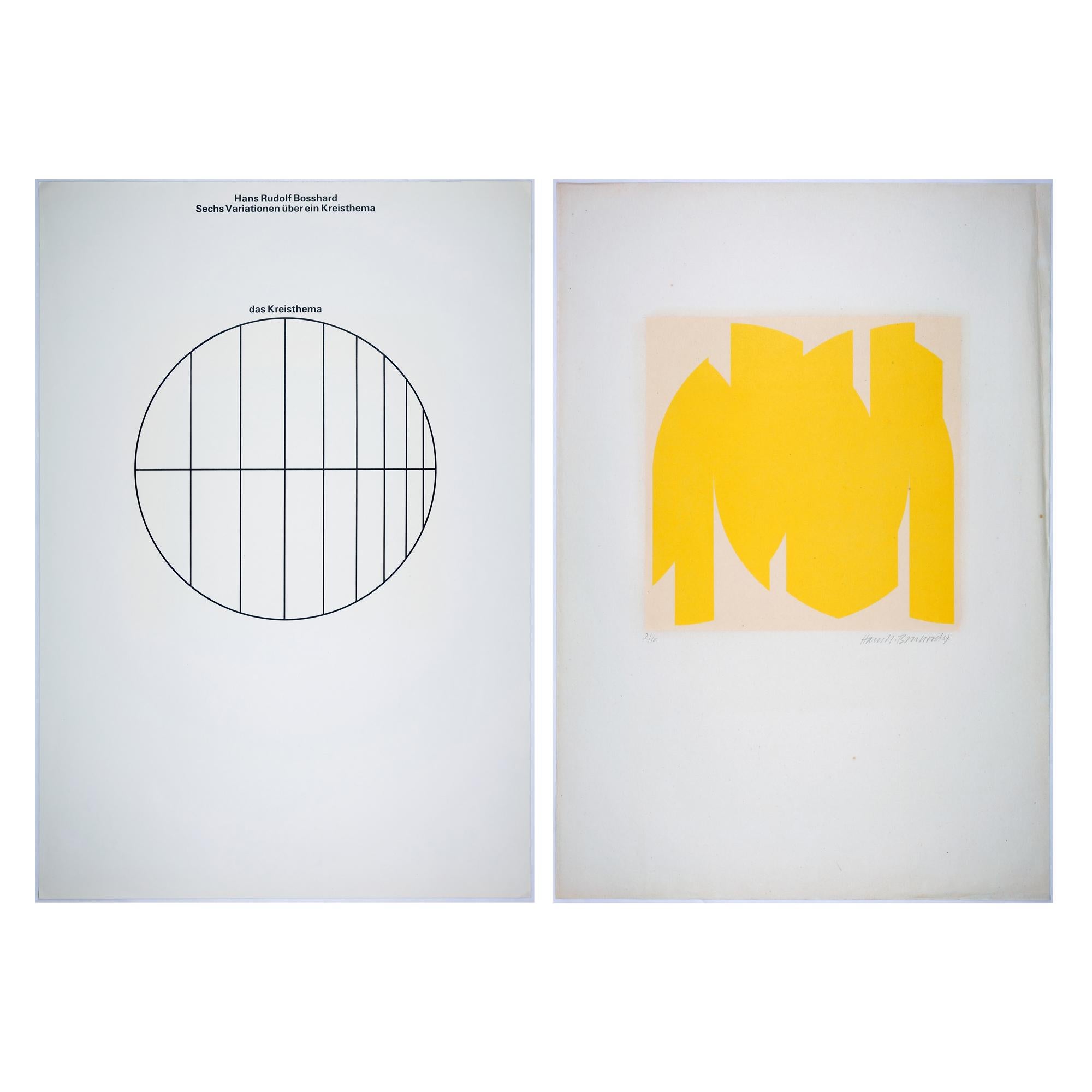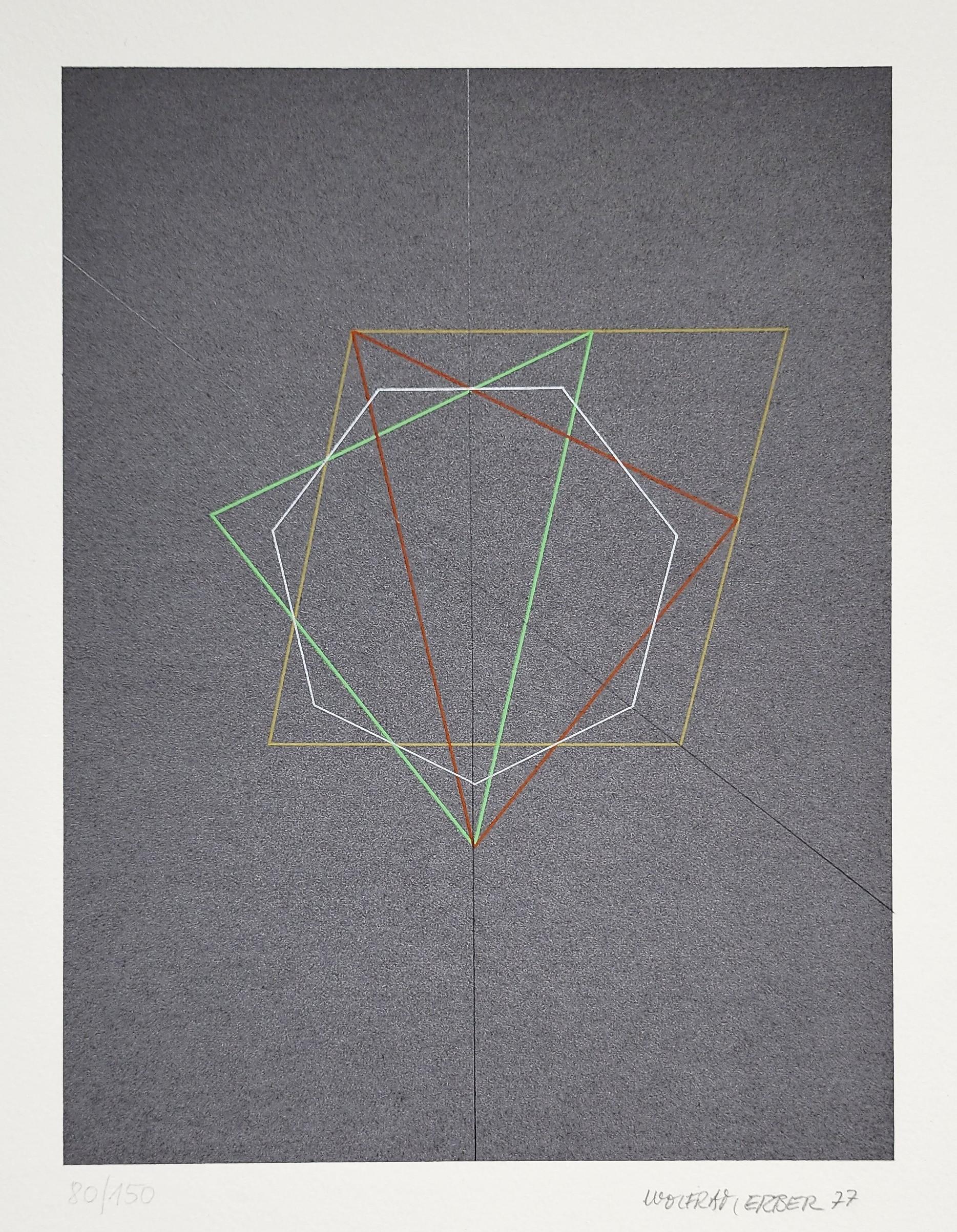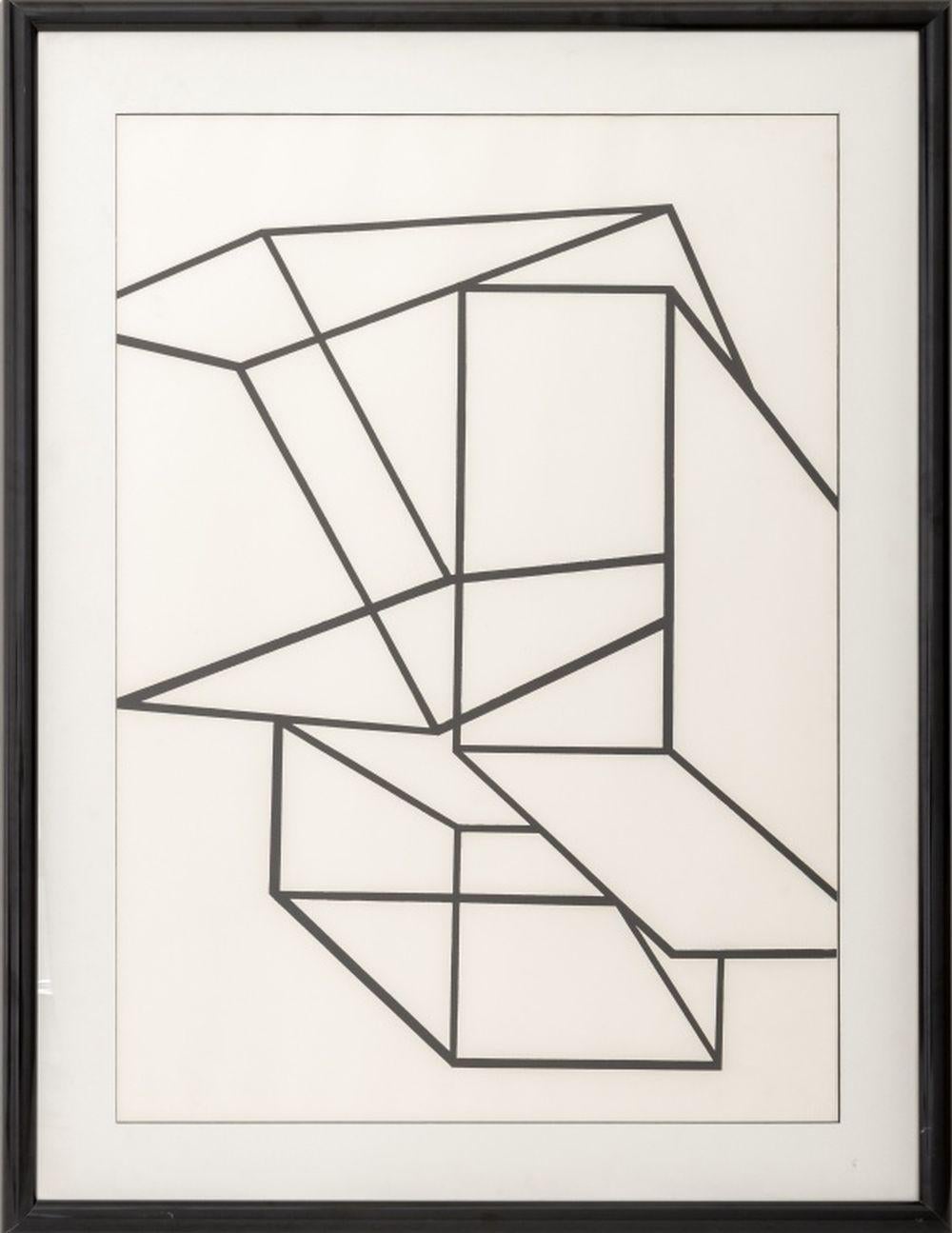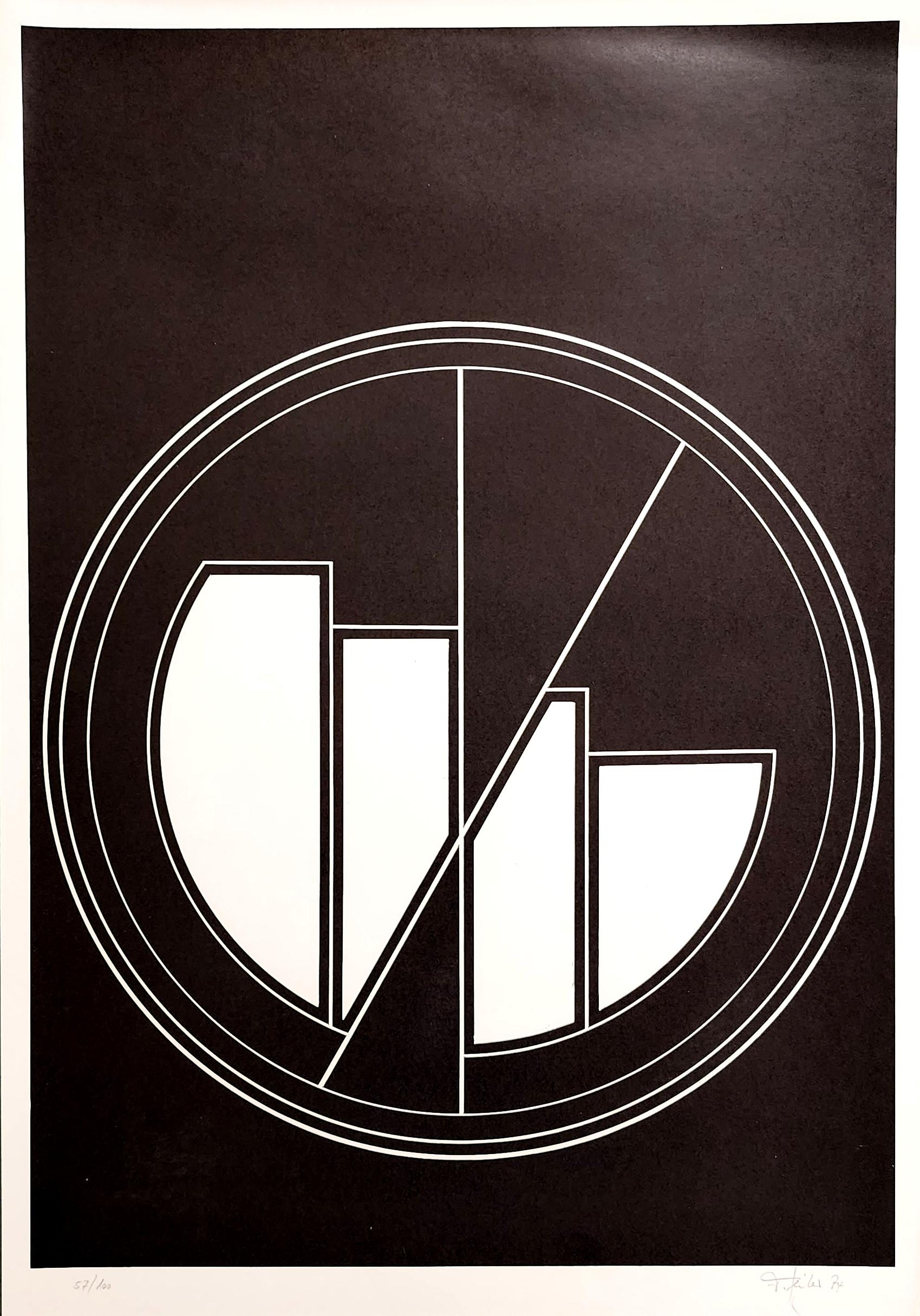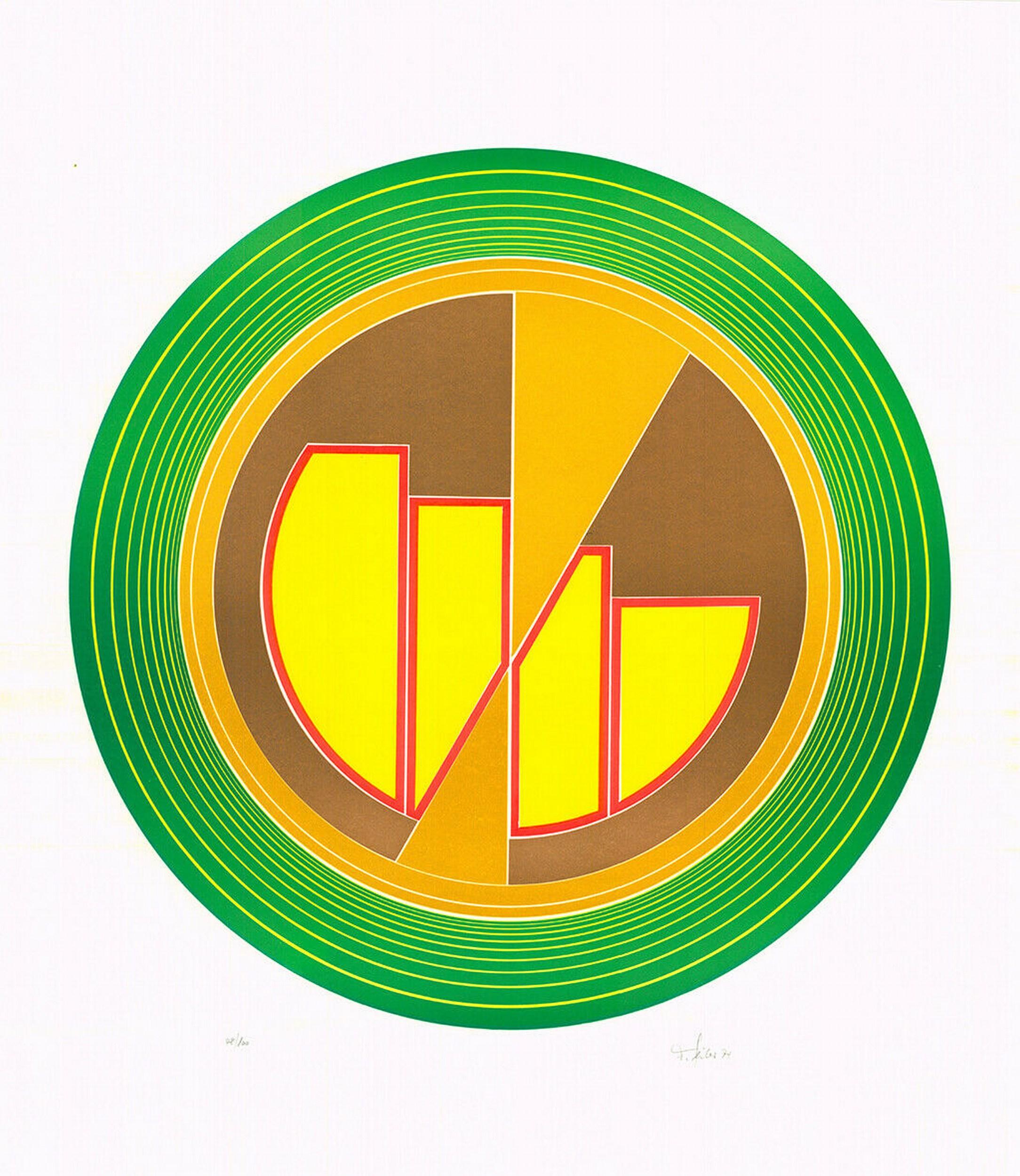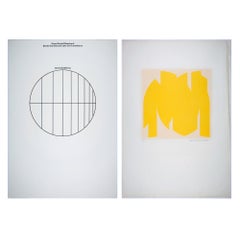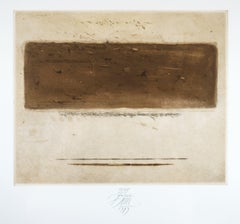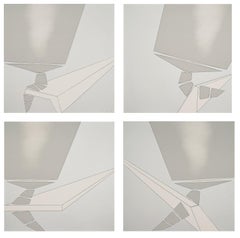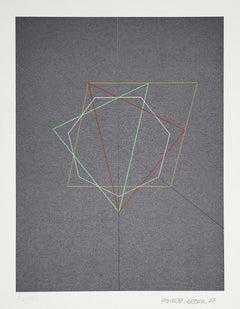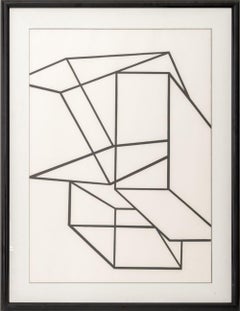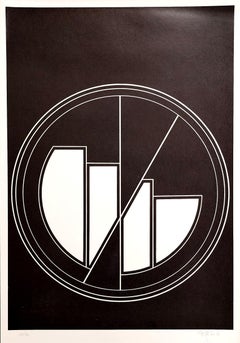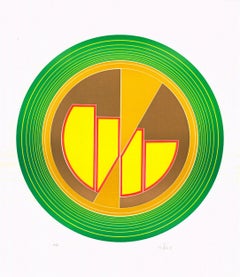Items Similar to Twelve variations on a dice theme / - The Musical Proportions of the Cube -
Want more images or videos?
Request additional images or videos from the seller
1 of 18
Hans Rudolf BosshardTwelve variations on a dice theme / - The Musical Proportions of the Cube -
$1,517.69
$1,897.1220% Off
£1,153.44
£1,441.8020% Off
€1,280
€1,60020% Off
CA$2,129.55
CA$2,661.9420% Off
A$2,323.82
A$2,904.7720% Off
CHF 1,206.20
CHF 1,507.7520% Off
MX$27,802.50
MX$34,753.1220% Off
NOK 15,310.51
NOK 19,138.1320% Off
SEK 14,341.15
SEK 17,926.4420% Off
DKK 9,752.40
DKK 12,190.5020% Off
About the Item
Hans Rudolf Bosshard (*1929 Balm-Lottstetten), Twelve variations on a dice theme, 1962. Portfolio with inserted cover sheet and twelve woodcuts on thin Japanese paper. Copy no. 2/10, sheet dimensions 61 cm (height) x 47 cm (width). Woodcuts each signed “Hans Bosshard” in lead, dated “[19]62” and numbered.
- Portfolio somewhat dusty and bumped, sheets with very occasional wood inclusions due to production.
- The Musical Proportions of the Cube -
With the musical terminology given in the title, "Variations on a Theme," Hans Rudolf Bossard makes it clear that the twelve images are not to be viewed as a sequence alone, but that they interlock like a sequence of notes. The artist has also materialized the interlocking, which corresponds to a musical theme, through the semi-transparent, thin Japanese paper. When the prints are placed on top of each other, the lower sheets shine through, so that in addition to black and white, shades of gray are also part of the rhythmic spatial structure, creating the impression of a depth structure that is only revealed. The "cube theme" depicted on the title page as a complex and precise interlocking is presented in the graphics - in analogy to the music - as a visual sequence of spatial sounds. In this way, Bossard activates musical principles for the minimalist Op Art of the time, whereby his prints develop a special effect through the intensity of the black, since Bossard did not produce screen prints or lithographs as usual, but woodcuts.
About the artist
In 1944, at the age of fifteen, Hans Rudolf Bosshard began an apprenticeship as a typesetter in Schaffhausen, which he completed in 1948. Since then, typography has been a defining leitmotif in Bosshard's artistic work, both in practice and in theory. For 30 years he taught typography at the Kunstgewerbeschule in Zurich and published his findings in various textbooks: Technical Foundations of Type Production (1980), Mathematical Foundations of Type Production (1985), Typography - Type - Readability (1996), and The Typographic Raster (2000).
As a visual artist, he initially worked in an expressionist style. However, the works of Richard Paul Lohse and Max Bill, which inspired him, made it clear that the geometric-mathematical conciseness already applied in typography held an artistic potential that Bossard began to exploit. Throughout his life, however, he remained faithful to the woodcut.
"Not a single one of his compositions is speculative.”
Hans Jörg Wüger
GERMAN VERSION
Hans Rudolf Bosshard (*1929 Balm-Lottstetten), Zwölf Variationen über ein Würfelthema, 1962. Mappe mit einliegendem Deckblatt und zwölf Holschnitten auf dünnem Japanpapier. Exemplar Nr. 2/10. Blattmaße 61 cm (Höhe) x 47 cm (Breite). Holzschnitte jeweils in Blei mit „Hans Bosshard“ signiert, auf „[19]62“ datiert und nummeriert.
- Mappe etwas angestaubt und bestoßen, Blätter herstellungsbedingt ganz vereinzelt mit Holzeinschlüssen.
- Die musikalischen Proportionen des Würfels -
Mit der in im Titel gegebenen musikalischen Begrifflichkeit, ‚Variationen über ein Thema‘, verdeutlicht Hans Rudolf Bossard, dass die zwölf Darstellungen nicht allein als Abfolge zu betrachten sind, sondern wie eine Tonfolge ineinandergreifen. Das einem musikalischen Thema entsprechende In-einander-gefügt-Sein hat der Künstler durch das semitransparente dünne Japanpapier auch materiell realisiert. Liegen die Grafiken übereinander, scheinen die jeweils unteren Blätter hindurch, so dass neben Schwarz und Weiß auch Grautöne Teil des rhythmisierten Raumgefüges sind und der Eindruck einer sich erst enthüllenden Tiefenstruktur entsteht. Das auf dem Titelblatt als komplexes wie exaktes Ineinander veranschaulichte ‚Würfelthema‘ wird auf den Grafiken – in Analogie zur Musik – als visuelle Raumklangabfolge dargeboten. Damit aktiviert Bossard musikalische Prinzipien für die minimalistisch ausgerichtete Op-Art der Zeit, wobei seine Blätter durch die Intensität des Schwarzes eine besondere Wirkkraft entfalten, da Bossard nicht – wie üblich – Siebdrucke oder Lithographien, sondern Holzschnitte anfertigt hat.
zum Künstler
Mit fünfzehn Jahren nahm Hans Rudolf Bosshard 1944 eine Lehre als Schriftsetzer in Schaffhausen auf, die er 1948 abschloss. Seitdem ist die Typographie in praktischer wie theoretischer Hinsicht ein bestimmendes Leitmotiv in Bossards künstlerischem Schaffen. 30 Jahre unterrichtete er unter anderem an der Kunstgewerbeschule für Gestaltung Zürich Typographie und publizierte seine Erkenntnisse in verschiedenen Lehrwerken: Technische Grundlagen zur Satzherstellung (1980), Mathematische Grundlagen zur Satzherstellung (1985), Typografie - Schrift - Lesbarkeit (1996) und Der typografische Raster (2000).
Als bildender Künstler schuf er zunächst in einem expressionistischen Duktus. Die ihn inspirierenden Werke von Richard Paul Lohse und Max Bill verdeutlichten jedoch, dass gerade die in der Typographie bereits zu Anwendung kommende geometrisch-mathematische Prägnanz ein künstlerisches Potenzial birgt, das Bossard fortan auszuschöpfen begann. Dabei blieb er allerdings Zeit seines Lebens dem bereits praktizierten Holzschnitt treu.
„Keine einzige seiner Kompositionen ist spekulativ.“
Hans Jörg Wüger
- Creator:Hans Rudolf Bosshard (1929, Swiss)
- Dimensions:Height: 24.02 in (61 cm)Width: 18.51 in (47 cm)Depth: 0.79 in (2 cm)
- Medium:
- Movement & Style:
- Period:
- Condition:
- Gallery Location:Berlin, DE
- Reference Number:1stDibs: LU2438215863372
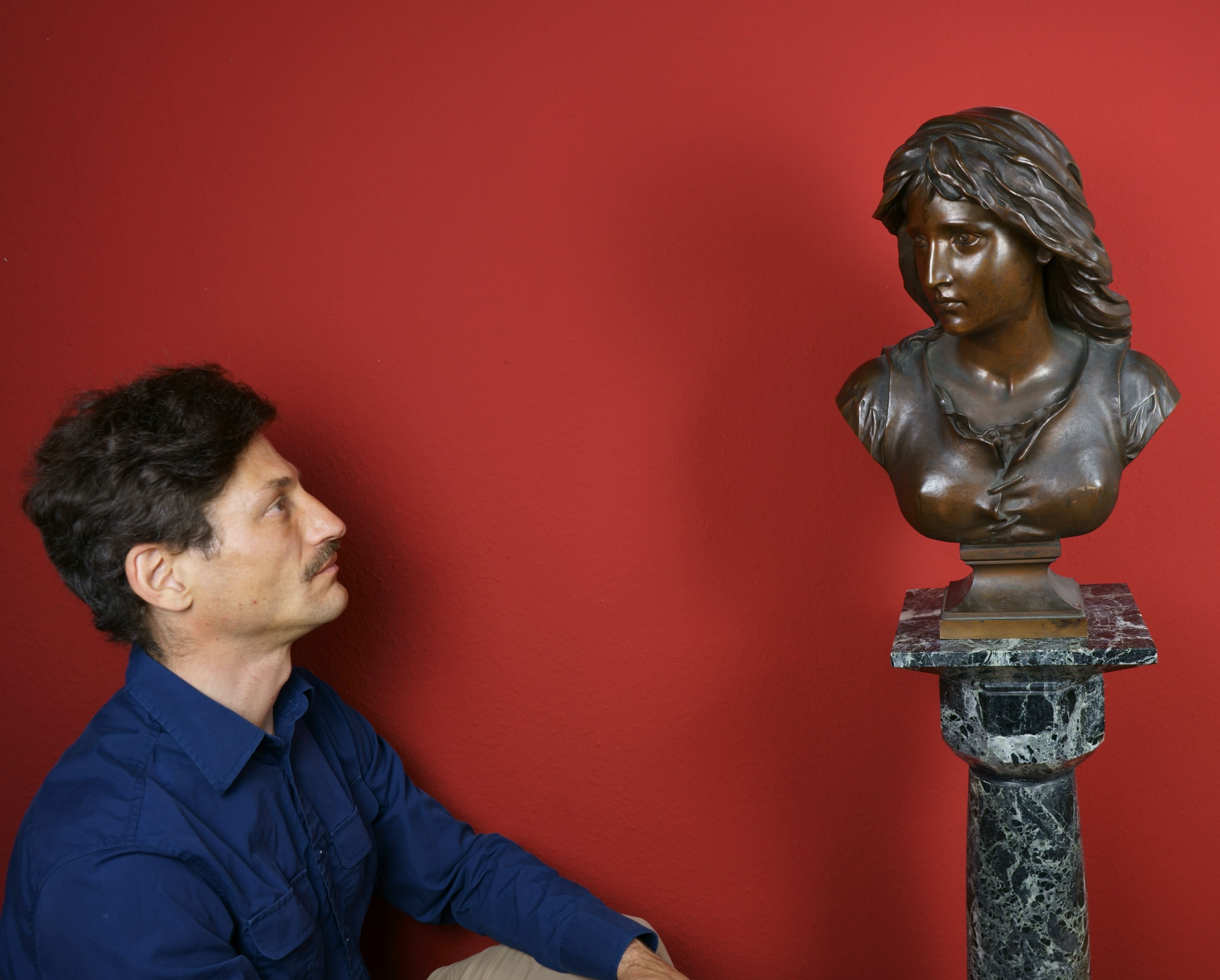
About the Seller
5.0
Vetted Professional Seller
Every seller passes strict standards for authenticity and reliability
Established in 2014
1stDibs seller since 2023
22 sales on 1stDibs
Typical response time: <1 hour
- ShippingRetrieving quote...Shipping from: Berlin, Germany
- Return Policy
More From This Seller
View AllSix variations on a circular theme / - The Musical Proportions of the Circle -
Located in Berlin, DE
Hans Rudolf Bosshard (*1929 Balm-Lottstetten), Six variations on a circular theme, 1967. Portfolio with inserted cover sheet and six color woodcuts on thin Japanese paper. Copy no. 6...
Category
1960s Minimalist Abstract Prints
Materials
Paper
Field - Field research -
Located in Berlin, DE
Karl Ludwig Mordstein (1937 Füssen - 2006 Wilszhofen), Field 1983. Color etching, copy 13/65, 22.5 x 28 cm (image), 40 x 45 cm (sheet), 43 x 48 cm (frame), titled, numbered, monogram...
Category
1980s Abstract Abstract Prints
Materials
Etching
$426 Sale Price
20% Off
Untitled / - The archaism of nature -
Located in Berlin, DE
Jorge Machold (1940 Chemnitz - 2015 Berlin), Untitled, 1973. Color etching, 41.5 x 29.2 cm (plate size), 49.5 cm x 39.5 cm (sheet size), signed lower right in lead “J.[orge] Machold”...
Category
1970s Abstract Abstract Prints
Materials
Paper
Untitled / - Dancing Sculpture -
By Gerlinde Beck
Located in Berlin, DE
Gerlinde Beck (1930 Stuttgart-Cannstatt - 2006 Mühlacker-Großglattbach), Untitled, 1973. Series of four serigraphs, 29.8 cm x 29.8 cm, each signed in lead on the front and numbered on the reverse. Sheet 1-3 no. 74/100, sheet 4 no. 48/100.
- Corners occasionally slightly bumped, minimal crease, otherwise in very good condition
- Dancing Sculpture...
Category
1970s Abstract Geometric Abstract Prints
Materials
Paper
Tectonic Tension / - Archetypes of Painting -
Located in Berlin, DE
Jürgen Möbius (*1939 Großenhain), Tectonic Tension. Oil on hardboard, 47.5 x 60 cm, 49 x 61.5 cm (frame), signed lower right "Möbius" and dated "[19]81".
- Upper left corner with a small chip, light scratches and a little rubbed in places. Provisional gallery frame with traces of use.
- Archetypes of Painting -
About the artwork
The form structure in front of the eye is overlapped by the frame. Thus, the frame does not open up a space in which something is presented, but rather shows the seemingly arbitrary section of a comprehensive context that cannot be framed as such.
We see forms that stand in a structure of tension with each other, whereby the individual black and brown forms, which continue almost endlessly beyond the frame, already show a tension in themselves, since they are not only forms, but also surfaces - form surfaces, while the light blue surface ground is at the same time forms that appear as surface forms. The formed surfaces and surface forms are nested within each other and form a structure that encompasses all elements.
The angular arrangement of the black and brown shaped surfaces gives the structure a tectonic character. The tension is thus heightened to the point of paradox, since the black shape at the front is overlapped by the brown shape at the bottom in the center of the picture, which would be impossible in real space. It is precisely through this "paradox" that Möbius demonstrates that the paradoxical is reality within painting. It is, so to speak, the most original possibility of painting, which distinguishes it from the other arts. In combination with the tectonic formations, Jürgen Möbius creates an archaic primordial painting, which, however, should not be confused with the autonomous color and form cosmos of Suprematism à la Kasimir Malevich. Instead of homogeneous, perfectly colored forms, here the colors are deliberately applied unevenly, and the light blue is mixed with the brown in a manner determined by the brushstroke. At the edges of the surface forms, the uneven application of paint allows the wood of the unprimed hardboard to show through. In this way, Möbius illustrates that we are dealing with a painting that has been created by an act of painting - an act, however, that takes hold of the original principles of painting and thus realizes painting as such.
About the artist
From 1959 to 1965 Jürgen Möbius studied painting at the University Institute for Art and Work Education in Mainz. He also studied philosophy and art history at the University of Mainz. Afterwards he worked as a freelance artist in Mainz.
At first, Möbius created material reliefs and installations, then, around 1974, he turned increasingly to conceptual art and added cinematic means. During this phase he wrote the manifesto-like essay "Principles of Supranatural Landscape" (1979).
From 1981 on, Möbius concentrated on painting and searched for artistic ways to "treat intellectual and sensual perception equally in the fusion of representational and abstract pictorial elements" (Wolfgang Zemter). He found inspiration on his study trips to Thailand and Sri Lanka.
"The pure painting of Jürgen Möbius flows through us as a timeless expression of memory and energy, ploughing our perception and bringing us the happiness of seeing authentic, immovable form.
- Philippe Büttner
Selection of solo exhibitions
1969 Galerie Würzner, Düsseldorf / Galerie Gurlitt, Mainz
1972 Städtische Galerie, Mainz
1973 Galerie Schloss Ringenberg Rathaus, Kleve
1974 Röderhausmuseum, Wuppertal
1976 Galerie Glasing, Osnabrück / Städtische Galerie, Herne
1977, 1997, 2004 Märkisches Museum, Witten
1979 Studio M, Bamberg / Staatstheater, Darmstadt
1980 Galerie Stolànovà, Wiesbaden / Mittelrheinmuseum, Koblenz
1982 Galerie Dornhöfer, Mainz
1984 Galerie Neumühle, Schlangenbad
1985 Landesmuseum, Mainz / Kunstverein, Ludwigshafen / Nassauischer Kunstverein, Wiesbaden
1986 Museum, Bochum / Galerie der Stadt Iserlohn
1987, 1990 Galerie Klaus Kiefer, Essen
1987, 2000 Galerie Ulrike Buschlinger, Wiesbaden
1988 Kunsthalle Darmstadt
1988, 1992, 1996, 1999 Galerie Leonhard, Basel
1992, 2002 Galerie Zulauf, Freisheim
1994 Galerie Remy, Vallendar
1995 Sendezentrum des Zweiten Deutschen Fernsehens, Mainz
2001 Collegium oecumenicum, Bamberg / MVB Forum für Kultur und Wirtschaft, Mainz
2006 Adam Gallery, London
Selection of group exhibitions
1969 ‘International Graphic Arts’, Galerie Dalléas Bordeaux, Paris
1975 ‘Deutscher Künstler-Bund’, Dortmund
1979 ‘Man and man’s Images’, Märkisches Museum Witten
1980 ‘Love-Dokuments of our Time’, Art Hall Darmstadt and Art Association Hannover
1982 ‘Work - Progress – Position’, Nassau Art Association Wiesbaden
1983 ‘Principle Hope – Utopic Aspects in Art and Culture of the 20th Century’, Museum Bochum
1986 ‘Selfportraits’, Gallery Klaus Kiefer Essen
1987 ‘The Dying and Death’, Gallery Klaus Kiefer Essen
1989 ‘Where are You, Revolution – Freedom, Liberty, Egality, Fraternity to-day’, Museum Bochum 1990 ‘Flight – a Problem within the Memory of Man’, Kunsthalle Darmstadt ‘Art and War 1939 – 89’, House of Cultures Berlin
1991 ‘Material and Form’, Pillnitz Castle Dresden and Pfalz Gallery Kaiserslautern
1995 20 Years Exhibitions, Chrämerhuus Langenthal, Schweiz
1998 ‘Works on Paper’, Klaus Kiefer Gallery Essen
2000 ‘Acquisitions 1900 – 2000’, Mittelrhein-Museum Koblenz
2001 ‘Strange Pictures’, Klaus Kiefer Gallery Essen
2002 ‘10 Years Buschlinger Gallery’, Buschlinger Gallery Wiesbaden
2004 ‘Eternal Space – Pictures and Sculptures’, Dome of Bamberg
2005 Art Fair Chicago, Adam Gallery, London
Selected Bibliography
Mittelrheinisches Landesmuseum (Hrsg.): Jürgen Möbius - Neue Bilder, Mainz 1985.
Kunstverein Darmstadt (Hrsg.): Jürgen Möbius. Bilder 1985 - 1988. Kunsthalle Darmstadt, 26. Juni - 14. August 1988. Red. Dorit Marhenke, Lyrik Marcus Schiltenwolf, Düsseldorf 1988.
Gabriele Prusko (Hrsg.): Jürgen Möbius. Mit Texten von Philippe Büttner und Ralph Mieritz, Basel 1992.
Wolfgang Zemter (Hrsg.): Jürgen Möbius - Aktuelle Arbeiten. Märkisches Museum der Stadt Witten, Bönen 1999.
Wolfgang Zemter (Hrsg.): Jürgen Möbius. Flieger in meinem Zimmer und Beruhigte Zone, Bönen 2004.
Dama Gallery...
Category
1980s Abstract Abstract Paintings
Materials
Oil
$1,327 Sale Price
20% Off
Collage with metal application / - Rhythm and Reflection -
Located in Berlin, DE
Hermann Goepfert (1926 Bad Nauheim - 1982 Antwerp), Collage with metal application, 1965. Contribution no. 14 from the anthology 'La lune en rodage II' published by Editions Panderma...
Category
1990s Abstract Mixed Media
Materials
Paper
$616 Sale Price
20% Off
You May Also Like
Untitled Geometric Abstraction
Located in Kansas City, MO
Wolfram Erber
Untitled Geometric Abstraction
Color silkscreen
Year: 1977
Signed and dated by hand
Size: 8.3×6.3in on 16.5×11.6in
COA provided
Ref.: 924802-1174
Wolfram Erber (1939-...
Category
1970s Abstract Geometric Prints and Multiples
Materials
Screen
$298 Sale Price
33% Off
Untitled (Cubes)
By Al Held
Located in Astoria, NY
Al Held (American, 1928-2005), Untitled (Cubes), Lithograph on Strathmore Paper, 1969, signed in pencil and numbered edition "67 / 100" to verso, Strathmore blindstamp lower right co...
Category
1960s Post-Modern Abstract Prints
Materials
Paper, Lithograph
Concrete Composition (Konkrete Kunst, Constructivsm, Geometric Abstraction)
By Friedrich Geiler
Located in Kansas City, MO
Friedrich Geiler
Concrete Composition (Konkrete Kunst, Constructivsm, Geometric Abstraction)
Linocut
Year: 1974
Signed, numbered and dated by hand
Edi...
Category
1970s Abstract Geometric Abstract Prints
Materials
Linocut
Untitled Composition (Konkrete Kunst, Constructivsm, Geometric Abstraction)
By Friedrich Geiler
Located in Kansas City, MO
Friedrich Geiler
Untitled Composition (Konkrete Kunst, Constructivsm, Geometric Abstraction)
Color Linocut
Year: 1974
Signed, numbered and dated by hand
Edition: 100
Size: 20.3 × 20....
Category
1970s Constructivist Abstract Prints
Materials
Linocut
Untitled II, Abstract Minimalist Screenprint by Robert Einbeck
By Robert Einbeck
Located in Long Island City, NY
Artist: Robert Einbeck, French (1944 - )
Title: Untitled II
Year: circa 1975
Medium: Screenprint on Arches, signed and numbered in pencil
Edition: 150
Image Size: 22 x 26 inches
Size...
Category
1970s Abstract Geometric Abstract Prints
Materials
Screen
"Homage to the Square: Ten Works by Josef Albers" - Abstract, Set, Square
By Josef Albers
Located in Köln, DE
Set of 10 colour screenprints by Josef Albers.
Edition of 250 copies on Mohawk Superfine Bristol.
Sheet dimensions each: 43 x 43 cm
Illustrations each: 28 x 28 cm
All works labell...
Category
1960s Abstract Geometric Abstract Prints
Materials
Screen
More Ways To Browse
Vintage Dice
Dice Art
Welcome Mat
Ace Gallery Poster
Alan Cote
Alan Thompson
Alexander Calder Balloons
Alexander Calder Hand Signed
Alfred MANESSIER On Sale
Andy Warhol Sunset
Art Poster Helen Frankenthaler
Banksy Welcome Mat
Calder Ea
Calder Flowers
Calder Lithograph Balloons
Calder Lithograph Pyramids
Calder Mcgovern
Calder Pyramid Prints
